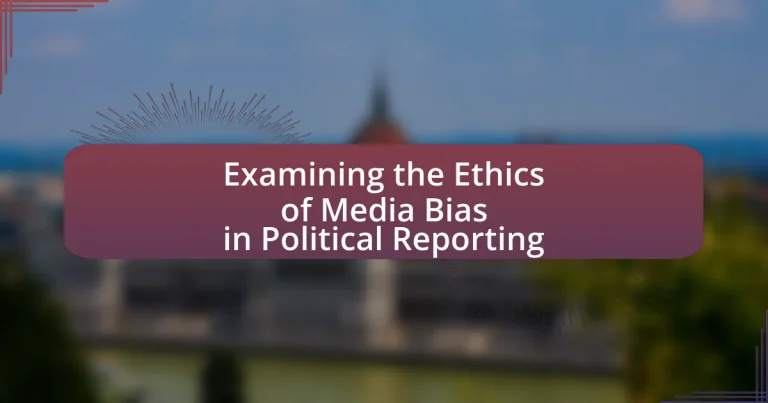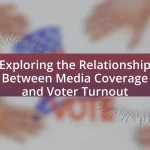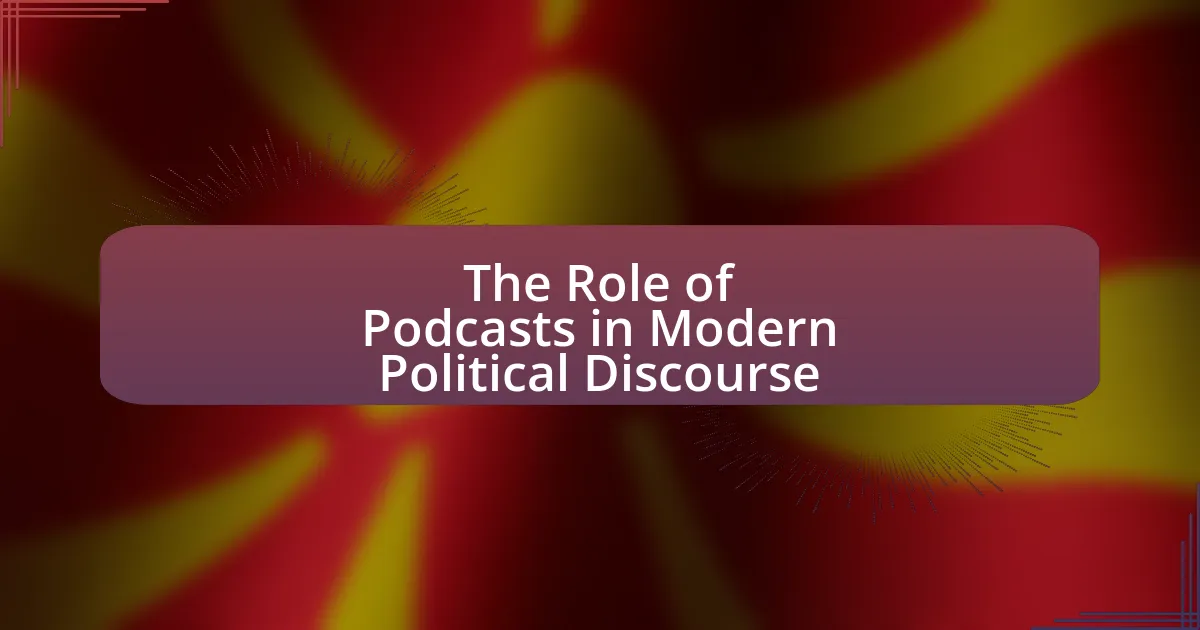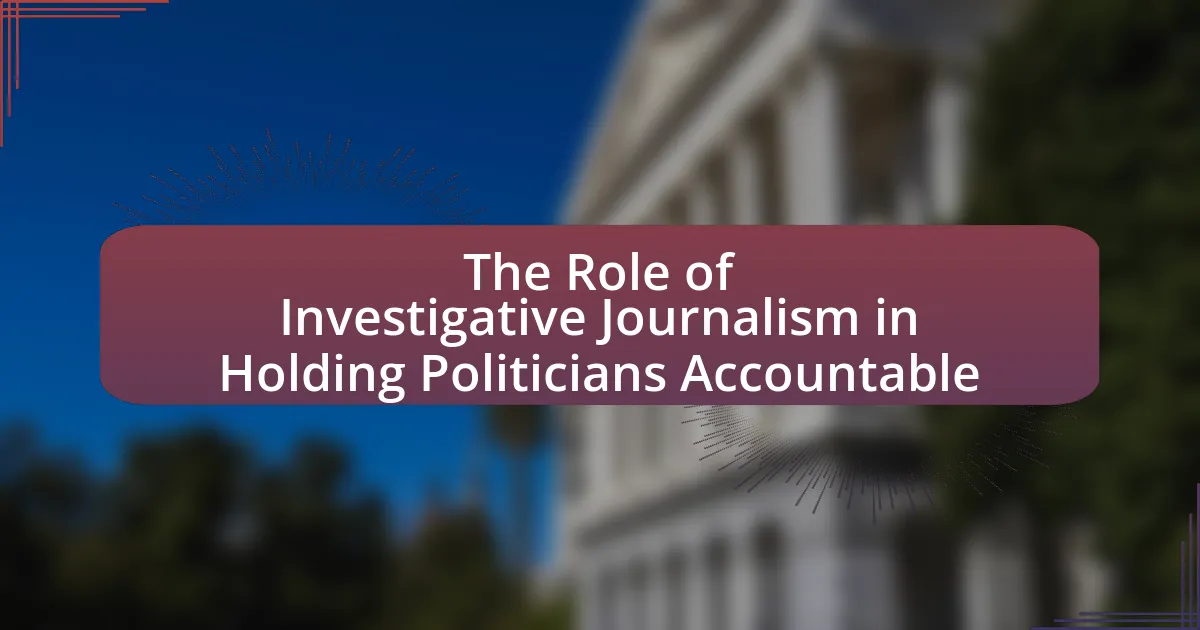Media bias in political reporting refers to the partiality exhibited by journalists and news organizations in their coverage of political events, which can influence public perception and discourse. This article examines the various types of media bias, including selection, framing, and confirmation bias, and their implications for political outcomes and public opinion. It highlights the ethical considerations surrounding media bias, emphasizing the importance of accuracy, fairness, and transparency in journalism. Additionally, the article discusses strategies for mitigating bias, promoting ethical reporting practices, and enhancing audience media literacy to foster informed public discourse.

What is Media Bias in Political Reporting?
Media bias in political reporting refers to the perceived or actual partiality of journalists and news organizations in their coverage of political events, issues, and figures. This bias can manifest through selective reporting, framing, or the use of language that favors one political perspective over another. Studies, such as those conducted by the Pew Research Center, indicate that media outlets often exhibit partisan leanings, influencing public perception and discourse. For example, research shows that audiences tend to gravitate towards news sources that align with their political beliefs, reinforcing existing biases and shaping political opinions.
How is media bias defined in the context of political reporting?
Media bias in the context of political reporting is defined as the perceived or actual partiality of journalists and news organizations in their coverage of political events, issues, and figures. This bias can manifest through selective reporting, framing of stories, or the use of language that favors one political perspective over another. Research indicates that media bias can significantly influence public perception and opinion, as evidenced by studies showing that audiences often interpret news differently based on the outlet’s political alignment, such as the findings from the Pew Research Center, which highlight how partisan news sources shape audience beliefs and attitudes.
What are the different types of media bias?
The different types of media bias include selection bias, framing bias, and confirmation bias. Selection bias occurs when certain stories or viewpoints are chosen over others, leading to an incomplete representation of events. Framing bias involves presenting information in a way that influences perception, often highlighting specific aspects while downplaying others. Confirmation bias refers to the tendency of media outlets to favor information that aligns with their existing beliefs or narratives, thereby reinforcing those views. These biases can significantly affect public opinion and the overall understanding of political issues.
How does media bias manifest in political news coverage?
Media bias manifests in political news coverage through selective reporting, framing, and language choices that favor one political perspective over another. For instance, studies have shown that news outlets may emphasize certain facts while downplaying others, leading to a skewed representation of events. A notable example is the coverage of the 2016 U.S. presidential election, where different networks exhibited varying levels of positivity or negativity towards candidates, influencing public perception. Research by the Pew Research Center indicates that partisan news sources often present information in a way that aligns with their audience’s beliefs, further entrenching biases. This selective portrayal can shape voter opinions and impact democratic processes.
Why is examining media bias important in political reporting?
Examining media bias is important in political reporting because it influences public perception and understanding of political issues. Media bias can shape narratives, affect voter behavior, and ultimately impact democratic processes. For instance, studies have shown that biased reporting can lead to misinformation, which can skew public opinion and alter election outcomes. A 2018 study by the Pew Research Center found that 62% of Americans believe that news organizations favor one side in their reporting, highlighting the significant role media bias plays in shaping political discourse.
What impact does media bias have on public perception?
Media bias significantly shapes public perception by influencing how information is presented and interpreted. Biased reporting can lead to skewed understandings of political events, issues, and figures, often reinforcing existing beliefs and polarizing audiences. For instance, a study by the Pew Research Center found that individuals who consume news from sources with a particular ideological slant are more likely to adopt similar viewpoints, demonstrating the direct correlation between media bias and public opinion formation. This impact is further evidenced by the 2016 U.S. presidential election, where partisan media coverage contributed to the deepening divide among voters, affecting their perceptions of candidates and policies.
How does media bias influence political outcomes?
Media bias significantly influences political outcomes by shaping public perception and voter behavior. Biased reporting can lead to the reinforcement of existing beliefs, creating echo chambers that affect how individuals interpret political events. For instance, studies have shown that exposure to partisan news sources can alter voters’ opinions and increase polarization, as evidenced by research from the Pew Research Center, which found that individuals who consume ideologically aligned media are more likely to hold extreme views. Additionally, biased coverage can impact election results by favoring certain candidates or parties, as seen in the 2016 U.S. presidential election, where media portrayal played a crucial role in shaping voter attitudes towards candidates.
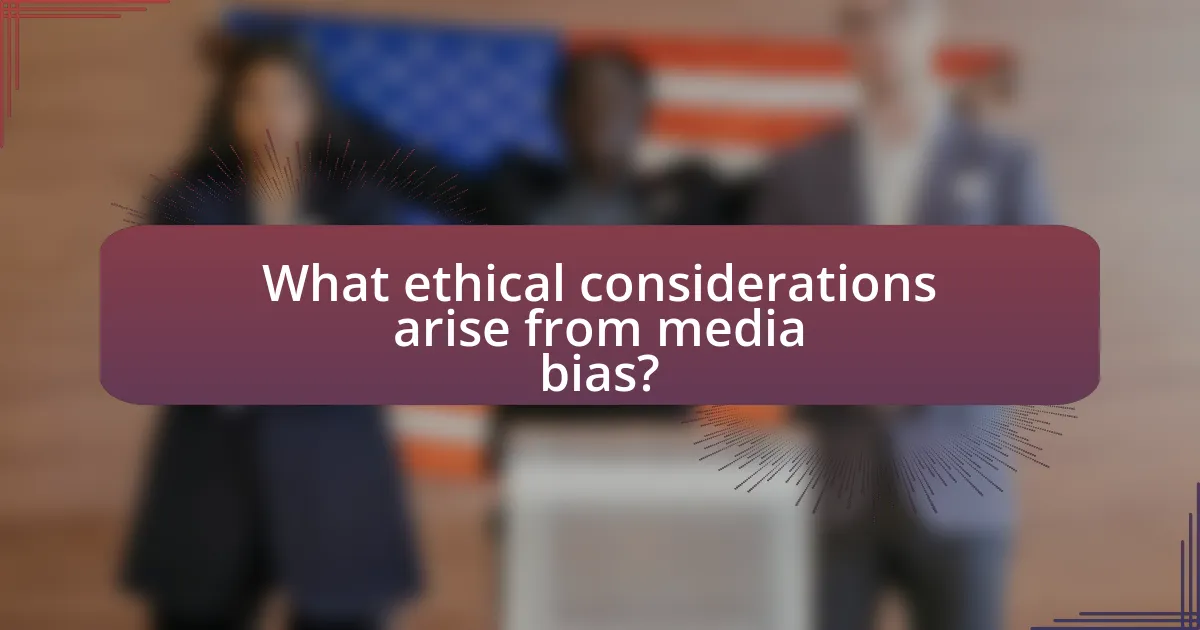
What ethical considerations arise from media bias?
Media bias raises significant ethical considerations, primarily concerning the integrity of information dissemination and the potential manipulation of public opinion. Ethical journalism mandates accuracy, fairness, and impartiality; however, media bias can distort these principles, leading to misinformation and a misinformed electorate. For instance, studies have shown that biased reporting can influence public perception and voting behavior, as evidenced by research from the Pew Research Center, which found that 62% of Americans believe that news organizations favor one side in political debates. This perception undermines trust in media, which is essential for a functioning democracy. Furthermore, media bias can exacerbate societal divisions by reinforcing existing beliefs rather than fostering informed discourse, ultimately challenging the ethical responsibility of media outlets to provide balanced coverage.
How do ethical standards apply to political reporting?
Ethical standards in political reporting ensure accuracy, fairness, and accountability in the dissemination of information. These standards require journalists to verify facts, provide balanced perspectives, and avoid conflicts of interest, thereby fostering public trust. For instance, the Society of Professional Journalists emphasizes the importance of minimizing harm and acting independently, which is crucial in a politically charged environment where misinformation can significantly impact public opinion and democratic processes.
What are the key ethical principles in journalism?
The key ethical principles in journalism are accuracy, fairness, independence, accountability, and transparency. Accuracy requires journalists to verify information before publication, ensuring that facts are correct and reliable. Fairness involves presenting all sides of a story without bias, allowing audiences to form their own opinions. Independence mandates that journalists remain free from influences that could compromise their integrity, such as political or commercial pressures. Accountability means that journalists must take responsibility for their work and be willing to correct errors. Transparency involves being open about sources and methods, fostering trust with the audience. These principles are foundational to maintaining credibility and public trust in journalism.
How do these principles relate to media bias?
The principles of media ethics, such as accuracy, fairness, and impartiality, directly relate to media bias by serving as benchmarks for evaluating journalistic integrity. When media outlets fail to adhere to these principles, they can present information in a way that skews public perception, favoring one political perspective over another. For instance, a study by the Pew Research Center found that 62% of Americans believe that news organizations are biased in their reporting, highlighting the impact of ethical lapses on public trust. Thus, the relationship between these principles and media bias is critical, as adherence to ethical standards can mitigate bias and promote balanced reporting.
What are the consequences of unethical media bias?
Unethical media bias leads to misinformation, eroding public trust in media sources. When media outlets present information in a biased manner, they distort facts, which can mislead audiences and shape public opinion based on inaccuracies. For instance, a study by the Pew Research Center found that 62% of Americans believe that news organizations favor one side in their reporting, indicating a significant perception of bias that can polarize society. This polarization can result in increased political division, as individuals may only consume media that aligns with their pre-existing beliefs, further entrenching biases and reducing constructive dialogue. Additionally, unethical media bias can undermine democratic processes by influencing elections through skewed reporting, as seen in various instances during electoral campaigns where biased coverage affected voter perceptions and decisions.
How can media bias lead to misinformation?
Media bias can lead to misinformation by presenting information in a way that favors one perspective over others, thereby distorting the truth. When media outlets selectively report facts, omit critical context, or use emotionally charged language, they can shape public perception inaccurately. For instance, a study by the Pew Research Center found that biased reporting can significantly influence audience beliefs, leading to the acceptance of false narratives. This selective portrayal can create echo chambers, where audiences are exposed only to viewpoints that reinforce their existing beliefs, further perpetuating misinformation.
What are the potential repercussions for journalists and media outlets?
Potential repercussions for journalists and media outlets include legal actions, loss of credibility, and financial penalties. Journalists may face lawsuits for defamation if they publish false information, while media outlets can suffer reputational damage that leads to decreased audience trust and engagement. For instance, a 2020 study by the Pew Research Center found that 70% of Americans believe that news organizations are biased, which can result in a decline in viewership and advertising revenue. Additionally, regulatory bodies may impose fines for violations of broadcasting standards, further impacting the financial stability of media organizations.

How can media bias be addressed and mitigated?
Media bias can be addressed and mitigated through the implementation of rigorous editorial standards and transparency in reporting. Establishing clear guidelines for balanced reporting ensures that multiple perspectives are represented, reducing the influence of individual biases. For instance, media organizations can adopt fact-checking protocols and provide context for news stories, which has been shown to enhance credibility and public trust. Research indicates that transparency about sources and funding can also help audiences critically evaluate the information presented, thereby fostering a more informed public.
What strategies can journalists use to minimize bias?
Journalists can minimize bias by employing strategies such as fact-checking, using diverse sources, and adhering to ethical guidelines. Fact-checking ensures that information is accurate and reduces the likelihood of spreading misinformation, which can skew public perception. Utilizing diverse sources allows journalists to present multiple viewpoints, fostering a more balanced narrative. Adhering to ethical guidelines, such as those outlined by the Society of Professional Journalists, promotes accountability and transparency, further mitigating bias in reporting. These strategies collectively enhance the credibility of journalism and support informed public discourse.
How can media organizations promote ethical reporting practices?
Media organizations can promote ethical reporting practices by implementing comprehensive training programs for journalists that emphasize accuracy, fairness, and accountability. Such training ensures that reporters understand the importance of verifying information before publication, which is crucial in maintaining public trust. For instance, the Society of Professional Journalists outlines a code of ethics that encourages journalists to seek truth and report it, highlighting the necessity of minimizing harm and acting independently. By adhering to these ethical guidelines and fostering a culture of integrity, media organizations can significantly enhance the quality and reliability of their reporting.
What role does audience media literacy play in combating bias?
Audience media literacy plays a crucial role in combating bias by enabling individuals to critically analyze and evaluate media content. This critical analysis helps audiences recognize biased information, discern credible sources, and understand the influence of media framing on public perception. Research indicates that higher levels of media literacy correlate with a greater ability to identify misinformation and bias, as demonstrated in studies like “Media Literacy and the Role of the Audience” by Hobbs and Jensen, which highlights that informed audiences are less susceptible to biased narratives. Thus, enhancing media literacy empowers individuals to challenge and mitigate the effects of bias in political reporting.
What are the best practices for ethical political reporting?
The best practices for ethical political reporting include ensuring accuracy, maintaining impartiality, and providing context. Accuracy is crucial; reporters must verify facts through reliable sources to avoid misinformation, as seen in the 2016 U.S. presidential election where false narratives spread rapidly. Impartiality requires journalists to present multiple viewpoints fairly, allowing audiences to form their own opinions, which aligns with the Society of Professional Journalists’ Code of Ethics. Providing context helps audiences understand the implications of political events, as demonstrated by comprehensive reporting on policy impacts rather than just political maneuvers. These practices collectively uphold the integrity of political journalism and foster informed public discourse.
How can journalists ensure balanced coverage?
Journalists can ensure balanced coverage by actively seeking diverse perspectives and verifying facts from multiple sources. This approach helps to mitigate bias and provides a more comprehensive view of the story. For instance, the American Press Institute emphasizes the importance of including voices from various stakeholders to reflect the complexity of issues, which enhances credibility and trust in reporting. By adhering to ethical guidelines and employing fact-checking methods, journalists can present information that is fair and representative of different viewpoints.
What tools and resources are available for journalists to assess bias?
Journalists can utilize several tools and resources to assess bias, including media bias rating websites, fact-checking organizations, and analytical software. Websites like Media Bias/Fact Check provide detailed assessments of various news outlets’ political leanings and reliability. Fact-checking organizations such as PolitiFact and Snopes offer verification of claims made in the media, helping journalists identify biased reporting. Additionally, analytical tools like CrowdTangle and NewsWhip allow journalists to track the spread of information and analyze engagement metrics, which can reveal patterns of bias in reporting. These resources collectively enhance journalists’ ability to critically evaluate the objectivity of news sources and reporting.
What steps can consumers take to critically evaluate political reporting?
Consumers can critically evaluate political reporting by verifying the credibility of sources, analyzing the language used, and cross-referencing information with multiple outlets. Verifying sources involves checking the background and reputation of the publication and the author, ensuring they have a history of accurate reporting. Analyzing language includes identifying emotionally charged words or biased phrasing that may indicate a slant in the reporting. Cross-referencing information with multiple outlets helps to identify discrepancies and provides a more balanced view of the issue. These steps are essential for discerning factual reporting from biased narratives, as studies show that media bias can significantly influence public perception and opinion.
